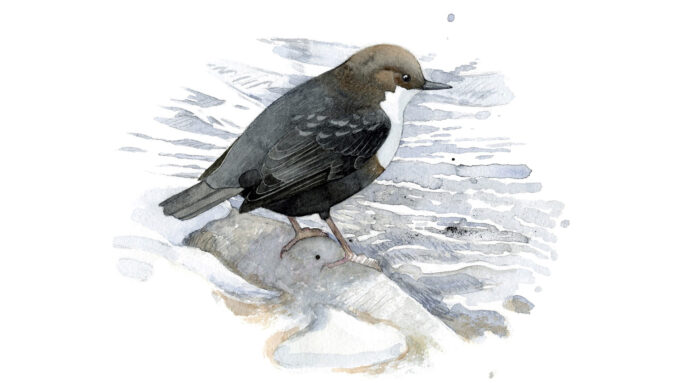Life in Käyrälampi Area
Can you hear the song of a bird in the winter landscape?
Tweet-tweet-tweet-tweet
It is a white-throated dipper (Cinclus cinclus), whose bright song can be heard in the vicinity of the flowing water all winter. The small dipper moves to Finland for the winter, mainly from northern Norway. Around March, it returns to its nesting sites in the north.

The dipper is best identified by the white side of the belly, which stands in stark contrast with its otherwise dark plumage. It is said the that the light colouring in the dipper’s chest favours its merging with the flowing water, acting like a reflective mirror in its search for food among the dark rocks.
The dipper spends its days diving for food in the water. It is often found bobbing on the rocks of a flowing river or on the edge of the ice, where it keeps a look-out for its prey. Upon spotting food, the dipper gracefully dives into the water, resurfacing after a while with food in its beak. The dipper’s diet includes, among other things, larvae of water insects.
The yellow-spotted whiteface (Leucorrhinia pectoralis), a protected dragonfly species, has been found in Käyrälampi. The species can be recognised by the yellow spot on its back.
The endangered Siberian flying squirrel (Pteromys volans) can also be found in the Käyrälampi area. It prefers to live in old mixed-spruce forests, where it can find hollow trees for nesting and deciduous trees for food.
Everyone’s rights
Respecting the peace of the forest is part of everyone’s right (formerly everyman’s rights). Over 800 species living in Finnish forests are endangered. One way to maintain biodiversity in nature and forests is to leave decaying trees in the forest, as decaying wood provides a home for many endangered plant and animal species.
Don’t forget to give birds some breathing space for nesting in the spring. Walking in the wild during the nesting period must be done so as to minimise any possible disturbance. This can be effectively implemented, for example, by avoiding fishing, spending time outdoors with pets, flying drones and boating near nesting areas.
Updated 7.2.2024